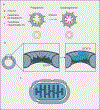Autophagosome biogenesis comes out of the black box
- PMID: 33903736
- PMCID: PMC8122082
- DOI: 10.1038/s41556-021-00669-y
Autophagosome biogenesis comes out of the black box
Abstract
Macroautophagic clearance of cytosolic materials entails the initiation, growth and closure of autophagosomes. Cargo triggers the assembly of a web of cargo receptors and core machinery. Autophagy-related protein 9 (ATG9) vesicles seed the growing autophagosomal membrane, which is supplied by de novo phospholipid synthesis, phospholipid transport via ATG2 proteins and lipid flipping by ATG9. Autophagosomes close via ESCRT complexes. Here, we review recent discoveries that illuminate the molecular mechanisms of autophagosome formation and discuss emerging questions in this rapidly developing field.
Conflict of interest statement
Conflicts of interest
J.H.H. is a co-founder of Casma Therapeutics.
Figures




References
-
- Mizushima N, Yoshimori T & Ohsumi Y. The role of Atg proteins in autophagosome formation. Annu Rev Cell Dev Biol 27, 107–132 (2011). - PubMed
-
- Lamb CA, Yoshimori T & Tooze SA The autophagosome: origins unknown, biogenesis complex. Nature Reviews Molecular Cell Biology 14, 759 (2013). - PubMed
-
- Nakatogawa H. Mechanisms governing autophagosome biogenesis. Nat Rev Mol Cell Biol 21, 439–458 (2020). - PubMed
Publication types
MeSH terms
Substances
Grants and funding
LinkOut - more resources
Full Text Sources
Other Literature Sources

